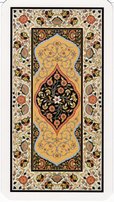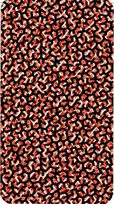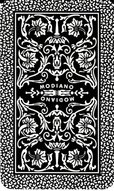Recently in Playing-card reviews Category
Wilhelm Tell cards are fairly common in the Central and Eastern Europe: Hungary, Austria, Slovenia, the Czech Republic, Croatia, Slovakia, western Romania and southern Tyrol. It is a rather beautiful pattern, full of interesting details. The pack has the German suits: hearts, acorns, leaves and bells. Generally, as far as I know, the packs have 32 or 36 cards: 2 (functioning as an ace), king, over, under, 10, 9, 8 and 7 in each suit.
The overs and unders are characters from the William Tell legend (particularly the William Tell play by Friedrich Schiller), hence the name. The over of acorns is Wilhelm Tell himself. The kings are anonymous. The aces feature the four seasons, which is why this pattern is also known as Four Seasons.
The pack was invented by Schneider József, a master card painter from Pest, in 1837. Hungarian Schneider chose the Swiss revolutionary Tell, because using Hungarian characters in the pack would've drawn too much attention from the government censors. Funny enough, this pack is not used at all in Switzerland, even though Tell is a Swiss character.
At least Piatnik sells these cards as Doppeldeutsche (Schnapskarten and others), magyar kártya, Mariáš Dvojhlavý or dvouhlavý and with other names, in various pack sizes (24, 32, 33).
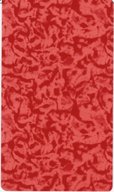
Wilhelm Tell Wilmoś (no. 2867) from Piatnik Editions is a reproduction pack. The box attributes it to Salamon Antal, Keczkemet. Keczkemet is in Hungary, near Budapest. There are no dates in the cards or the box, so I have no idea how old this pack is. I would appreciate even short historical notes in these historical reproductions, because there's very little information available in the Internet.
Anyhow, it is a neat pack. The cards look very old: the colours are unprecise, the background is brown and spotty, but the pictures have some character and style. Of course the material of the cards is excellent, they just look old and worn.
It's fun to compare the cards to the newer versions: obviously they are in the same tradition. The court cards are different, but the smaller pictures in the number cards are more alike in the old and new packs. The new packs are better for playing, but for artistic reasons this pack is well worth having (and it's possible to play games with it, too, no problem about that).
The name, by the way, is cleverly German-Hungarian: William Tell is Wilhelm Tell in German (and in Finnish, too) and Tell Wilmoś in Hungarian, as Hungarian names are written with last name first and first name last.
Piatnik magyar kártya (No. 1812 for blue, 1813 for red and 1816 for mini version) is a modern Hungarian version of the pack with 32 cards. Magyar kártya means "Hungarian cards". The cards have texts in Hungarian, so Spring is Tavasz, Summer is Nyár, Autumn is Ösz and Winter is Tél. All the names have their Hungarian forms, as well.
The pictures have mostly the same topics as in the old version, but these are different pictures. Funny detail: in the seven of Hearts, there's a rider wounded by an arrow. There are two bushes in the bottom corners of the card. In the old version above and in the modern pack with German texts, there's a small dude in one of the bushes looking guilty. In this version the dude is missing.
It's interesting, these small details, how the pack has certain standard topics: 8 of Hearts shows a man standing in a small boat, 8 of Bells is the Tell family, 9 of Bells has a wooden fence and a stick with a hat and so on. It's a standard pattern, but with individual variations. The pictures are detailed and rather lovely. (Actually, Richard Heli's Customs: Card Games of the Donauschwaben in 18th- and 19th-century Hungary has explanations for the different scenes.)
This Hungarian pack, apparently the traditional standard pack used in Hungary. It's a practical pack; even though it's pretty, it's also good for games. Of course, it'll take some getting used to, since there are no corner indices. Number cards have Roman numerals. In the court cards, Over and Under are indicated by the location of their suit symbol (top for Over, bottom for Under). Kings have crowns and horses, and no names. It's slightly confusing at first, but it's easy to learn.
The Hungarians use these cards for Ulti (one of the most complicated versions of Marriage games), Zsírozás (interesting variant of Finnish Ristikontra), Preferansz (the local variation of Preference) and many others.

Piatnik Doppeldeutsche (No. 1883 for red Blitz back, 1884 for Karo back pictured here, 1846 for the extra-large Kaffeehaus version and 1808 for Ornament back pictured above; 1885 for Blitz with 36 cards and 1886 for Karo with 36 cards), Doppeldeutsche Schnapskarten (No. 1756 for red Blitz back, 1760 for Karo back and 1730 for Ornament back), Mariáš dvouhlavý (No. 1848) or Mariáš dvojhlavý (No. 1809) - whew! So this is a fairly common pattern! This is the German version, with all the names and seasons in their German form. It is used in Germany, Austria, Slovakia, Czech Republic and probably other places as well.
The Doppeldeutsche packs have 32 cards (A, K, O, U, 10, 9, 8, 7), except for the ones with 36 cards (adding sixes). Doppeldeutsche Schnapskarten has 24 cards (just A, K, O, U, 10, 9), even though Schnapsen is, as far as I know, these days usually played with just 20 cards. Mariáš packs have 33 cards: the regular 32-card pack and the six of bells with acorn and heart symbols and the text "WELI". This is generally an Austrian feature, I believe, but apparently it is used elsewhere as well.
One would think that the Hungarian and German versions of the pattern are the same except for the texts, but that is not correct. As I said above, the patterns differ. They look the same, but they are different - the devil is in the details, there are subtle differences. Otherwise this is the same, all the basic features of the packs are the same.
I have the Slovakian Mariáš pack and the Schnapskarten pack (and two copies of the Hungarian pack - accidentally - and the historical reproduction pack), which gives me a nice selection of these Wilhelm Tell packs. I've found these packs intriguing and interesting: the way the cards tell a story and feature named characters is very charming. These are also very good playing-cards once you get to know them.
Piatnik makes some very beautiful 54-card Austrian-style Tarock packs with French suits . The first of my playing-card reviews covered one of them; here are the rest. Start with that review, because the packs are actually all exactly the same on the front. What differs is the back and the presentation.
Two of the packs have two-part boxes while the rest are in tuckboxes. The two-part boxes are very nice. The material is thick and the boxes are very sturdy. They are easy to open; too easy, actually, so when traveling, the box needs a rubber band or something to keep shut. The tuckboxes look less impressive, but are more functional.
Piatnik No. 1903 Luxus Tarock has a shiny golden box with blue decorations and text; whether it says "Luxus" or "Kitsch" is a question of taste, I suppose. The back of the cards repeats the same blue-and-gold theme. Piatnik No. 1905 Jagd Tarock is a pack for hunters, as the name says ("Jagd" means "Hunt"). The box is simple green with some ornaments and the back of the pack has a painting of a deer.
Piatnik No. 1906 Persisches Allerfeinstes has a Persian theme, all swishy ornaments typical to Arabic art. The name claims high quality (if I understand the "Allerfeinstes" correctly), but the cards are of the same quality as other Piatnik cards.
Piatnik No. 1909 Kaffeehaus stands out. The cards are very large. It doesn't appear so in the thumbnails below, but you can compare the actual images. While the regular Tarock cards are large, 63 x 113 mm, Kaffeehaus cards are huge: 74 x 129 mm. Why is that so, I don't know, but apparently some coffee house card players in Austria have preferred these larger cards. Piatnik also has Kaffeehaus Doppel-Deutsche cards. Other than the size, there's just one difference: the frame around the face cards is slightly more decorative than the simple thin line in other Piatnik Tarock cards.
Piatnik No. 1934 Blitz, No. 1935 Ornament and No. 1936 Karo are all very basic packs in standard tuckboxes, with different backs. These are common back patterns, too, for Piatnik, particularly Karo and Blitz (Kaffeehaus is Karo with slightly different colours). The different Ornament packs (Schnapskarten, Preference) have different ornament patterns, but are otherwise similar to this Tarock pack.
So, all are very good choices if you're looking for a Tarock pack. If you need really, really large cards, Kaffeehaus is the way to go, but all of these are large enough for people with weaker eyes. Luxus and Jagd have the boxes, which are nice unless you plan to carry your cards around with you. The rest is just a question of taste; I myself prefer Blitz and Karo.
Top row: 1903 Luxus, 1905 Jagd, 1906 Persisches Allerfeinstes, 1909 Kaffeehaus. Bottom row: 1934 Blitz, 1935 Ornament, 1936 Karo.


ASS Tarock Schafkopf Club and Piatnik Schafkopf Tarock (no. 182211). These packs (ASS on left, Piatnik on right) have the same Bayerisches Bild pattern with 36 cards. The Bavarian pattern has suits of acorns (Eichel), leaves (Graß), hearts (Herz) and bells (Schellen). The face cards have a king and two officers, Ober and Unter. While the pictures in both packs are clearly renditions of the same pattern, the quality of the drawings is substantially different.
The pip cards look pretty much the same, there are some differences there but which one is better is very much a question of taste and almost arbitrary. However, the face cards and the decorative aces (or twos, actually) are done in different styles. Piatnik has a lot more detail, fine lines and softer colours, while ASS has stronger pictures that look almost crude when compared to those in the Piatnik pack. My personal opinion is clear: Piatnik is much better. Even in the pip cards, I prefer Piatnik's colours, which are slightly deeper and less bright.
Both packs are excellent in production quality, though. The material is strong and durable. The cards are quite a bit taller than standard playing cards (10 cm or 4" tall, compared to a more typical 8.5 cm) but only slightly wider than usual. Thus, the cards appear tall, which is actually quite nice. All cards have indices - both suit and number - and the tens also have a large "X" in the top middle. Despite indices, Obers and Unters also have the suit symbols in the right place (up in Obers, down in Unters). All cards are double-headed.
The highlights and identifying features of the pattern are the seated kings and the decorative twos or aces (despite having indices "A", the aces clearly have two suit symbols, betraying their origin as twos). The ace of acorns features a naked cherub sitting on a barrel hoisting a tankard, with plants that look like hops. The ace of bells has a dog fighting a boar. The ace of leaves has a decorative cup with roses and the ace of hearts has Amor with his arrow.
Like the name says, these cards are used for Tarock and Schafkopf. For Schafkopf, though, the players need to toss away the sixes, and according to Card Games, these days many use 24 cards, which would make 24-card Schnapsen pack more attractive for Schafkopf. Bavarian Tarock, however, uses all 36 cards, and is a rather fine game.
Top row is ASS, bottom row is Piatnik.
Dal Negro Salzburger 24/D. This is a related pack from Italy, the only Italian regional pack with German suits. It is also known as Salisburghesi or Einfachdeutsch. The pack is used in Northern Italy, in the German-speaking regions. The pack often has 36 cards: Ace, King, Ober, Unter, 10, 9, 8, 7 and 6 in every suit, but this pack from Dal Negro has also fives to make 40 cards (according to Andy Pollett, this is a standard practise these days). Italian-speaking people in Alto Adige use this pack to play Tressette.
This pack also has a WELI card, that is, the six of bells has a large "WELI" text in the top, an acorn and a heart and a fountain in the bottom. This card is used in some Tyrolean games played with a 33-card pack (number cards 7-10 in every suit and WELI).
The pattern is not the same as in the Schafkopf / Tarock packs described above, but very close. The kings are also seated, and the twos (or the aces) have mostly the same pictures. However, these cards are single-ended (thus the name Einfachdeutsch; the Bavarian pattern is known as Doppeldeutsch in Austria, where this Salzburger pattern is also used). The court cards are rather beautiful, and the number cards have all sorts of little drawings (animals, hunting scenes, farm life) in the bottoms under the pips.
However, the double-ended cards are much better for playing games, which is the very reason why the Doppeldeutsche pack is double-ended these days. Add to that the lack of indices, and this pack becomes less attractive for games. The only way to tell Obers from Unters is to look at the location of the suit symbol in the card.
Thus, the pack is mostly interesting for art or authenticity - if you're looking for a pack to play with, I would suggest one of the above Tarock packs.
This time I'm taking a look at some Italian regional packs. I happen to have two copies of the Piacentine pack by different makers, which offers some comparison possibilities.
Italy has 16 different regional packs, which are divided to four different styles: northern Latin suits, southern Latin suits, French suits and German suits. Both Piacentine and Napoletane represent the southern style. The suits are clubs, swords, coins and cups. This style is influenced by the Spanish style, as the Southern Italy where this style originates was under Spanish rule at the time.
These two are the two most popular patterns in Italy. Piacentine in particular - the pattern is popular in the Central Italy and also used in the North with the local styles. Piacentine dates back to late 18th century, while Napoletane is younger, dating from 19th century.
Both are rather similar and feature the signs of Spanish style. The clubs or batons are knotted wooden cudgels, while the swords are short and straight. Northern styles have long and straight ceremonial batons and long curved swords. Also, the symbols in the card are separate from each other: the swords and the batons don't cross each other.
These are typical Italian packs: all three have 40 cards with numbers 1-7 in each suit and three court cards: a jack, a horseman and a king.
The games to play with these packs are Scopa and Briscola.


Dal Negro Piacentine 109 and Modiano Piacentine 81/25. These packs (Dal Negro on the left, Modiano on the right) follow the same pattern and generally look the same. Both are clearly based on the same pictures, but the art is not exactly the game. The Modiano pack has stronger lines and perhaps more vivid colours, while the Dal Negro pack has slightly finer details in the pictures.
It's entirely a matter of opinion which of these packs is better. Modiano's stronger lines happen to please me more, but I'm sure someone might prefer Dal Negro. Below you can see the ace of cups from both decks, perhaps that will demonstrate the differences between the packs.
As usual, these packs lack indices, both numbers and suit symbols. It's not a problem here, in general, as the cards are very clear. Since the numbers only run to seven, counting the symbols and recognising the different number cards is easy. The double-headed courts are easy to tell apart, despite the lack of ladies.
The most mysterious card in these packs is the ace of coins, which sports a large eagle. The eagle has a circle in it and before, the circle was the place where the tax stamp was. In Dal Negro's pack, the circle is white, so there's no sign of coins in the card. In Modiano's pack, the circle has a large coin. Still, it might confuse someone.
In general these are pretty packs, the art is colourful. I also like the very large suit symbols in the lower number cards. The court cards are perhaps somewhat clumsy and the double-headed style doesn't suit them very well, but this looks like a fun pack to use. Both packs have two extra cards: pointless logo cards in Dal Negro, rules to Briscola and Scopa (in Italian) in Modiano. Both come in regular tuckbox, but Modiano's is larger and better (their boxes are always very good).
Here are the pictures. Top row is Dal Negro, bottom row is Modiano.
Modiano Napoletane 97/25. This southern pattern is similar to Piacentine, but has few key differences. The cards are slightly smaller (as wide as Piacentine cards, but almost a centimeter shorter). There are no frames around the cards. The suit symbols are perhaps slightly more minimalistic and generally smaller, especially in the cards with many of them.
The court cards are single-headed and look rather classy, if you ask me. To my eyes Napoletane is more pleasant than Piacentine. The strong, bold style reminds me of some Tarocco packs. There are some interesting details. The ace of coins has an eagle, but the eagle is two-headed, which is unique. The three of clubs has a yellow face with big mustache. Five of swords has a small hunting (or is it sowing? some rural activity anyway) scene drawn in it and the horseman of swords is a Moor.
All in all, Napoletane is a charming pack and if you want just one Southern Italian pack, this would be my recommendation. The pictures are lovely and the cards are good for playing as well, thanks to the very clean design of the cards. No indices here, either, but the cards are easy to read. The pack is of usual Modiano quality.
This time I'm taking a look at some Doppelkopf packs. These packs have 48 cards, but they are actually made of two 24-card packs. Thus, the packs have A, K, Q, J, 10, 9 in each suit twice. Doppelkopf is a very good game, developed from Schafkopf. In Doppelkopf, or Doko as it's also known, there are four players and usually the two players who have the club queens play together against the other two. It's a complicated game, but for serious card players, Doko offers interesting challenges and is highly recommended.
You can also use the Doko pack to play Pinochle and of course, split it to make two packs for playing Schnapsen...

ASS Doppelkopf Deutsches Bild. This Doppelkopf pack from ASS (here's a tip: if you search for their home page, search for Altenburger...) has German suits and pictures. That is, the four suits are hearts, acorns, leaves and bells. The court cards are king, ober and under. The obers and unders have the correct suit symbols: ober is marked with a suit symbol in the top corner and under in the bottom corner. However, all cards have indices as well (courts are K, O, U). The cards are also double-headed.
Highlights of the pack include the very beautiful aces. Shown below is the ace of hearts, but the others are just as decorative. The court cards are rather fancy as well. The theme is old-fashioned country-side style, as suits the symbols. Under of acorns is falconer, for example, while under of leaves brandishes a milk jug and a hoe. The bells are all very high-and-mighty figures, even the under wields a sword and a book. Very beautiful.
The pack also has six cards with the official rules of tournament Doppelkopf - in German, unfortunately. The cards come in a clear two-part plastic shell, which is fairly functional but needs a rubber band to stay shut. All in all, this is a handsome and useful pack, and a good choice if you wish to play Doppelkopf with the German pictures - which of course limits the potential users quite a bit outside Germany.
Piatnik Doppelkopf Franz. Bild, No. 182419. This Piatnik pack has French pictures, which means it has the standard suits: hearts, diamonds, spades and clubs. The indices are German, though: K, D, B, and actually, the pictures are German as well. You see, in the Anglo-American standard courts, king of clubs represents Charlemagne (see Ron Decker's explanation) who holds the globe. In this pack and other German packs, it's the king of hearts who holds the globe. Also, here king of spades can be recognized as David, as he has his harp. In the Anglo-American standard pattern, the harp is not always visible.
The art here is very elegant and pleasant. The cards are of high quality and packed in a simple cardboard tuck box. Given the French suits, this is easier to approach than the pack with German suits, so if you're looking for a pack of Doppelkopf cards, here's a good pick. Of course, if you don't play Doppelkopf, this pack won't have much use either and the value of the pack is in the art. If your collection doesn't yet have a pack with the German-style courts with David as king of spades, that might be a reason enough to get this pack.
This time I'm taking a look at some Tarot packs that are perhaps better suited for enjoyment as art, not as playing-cards.
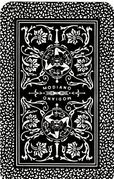
Modiano Tarocco Siciliano. The first thing one notices is the small size. The cards are as wide as typical Bridge cards, but even shorter. Thus, they are a lot smaller than Tarot cards usually are. The pack has just 64 cards. The suits (Italian symbols, but the card design bears signs of the Portuguese pattern - according to Dummett and McLeod this pack is the sole remaining representative of the Portuguese pattern in Europe) have cards 5-10 and the four court cards with coins having also 4 and ace. The jacks are female. Pip cards have indexes, while court cards are fairly easy to tell apart.
There are numbered trumps from 1-20 and two unnumbered trumps, Miseria and Fool. Miseria depicts a beggar with the text Miseria on top. The trumps have fairly typical pictures, but in unusual order and with some curiosities. For some reason I found the Hanged Man card rather disturbing: usually he is hanged from the foot, but in this pack he's hanged from his neck with his back turned to the watcher. The Sun shines over a fight, too - the art is beautiful, but rather strange at times. There's apparently some remains from Minchiate influences as well.
For most people this pack will be a curiosity only. There are several games known from Sicily, where it seems they play a different kind of Tarot in the different villages. Dummett and McLeod document several games in their book (A History of Games Played with the Tarot Pack), but none of those descriptions are available on Pagat. I'm going to make some effort to try at least one of the games, the pack is curious enough to guarantee that, but for most people that's not an option.
So, while the pack is perfectly functional for playing - the cards are clear enough, the material good and so on - for most people the value of this pack is in the art. I would recommend the pack for that use as well, as the cards are beautiful and the trumps are curious and fairly unusual. Also, if you want a pack of Tarocco Sicialiano cards, this is your only option, nobody else makes these cards anymore.

Jean Noblet Tarot de Marseille. Tarot of Marseilles is one of the major styles in Tarot cards, and the source where most occult Tarot traditions draw from. The pack designed by Jean Noblet in 1650 is a fine example of the style. There is one remaining copy of the pack in Bibliothèque Nationale in Paris. Fortunately it is nearly complete, missing only few pip cards from the swords. This reproduction by Jean-Claude Fornoy is based on the original cards, faithful to the original line drawings and with new, bright colours.
Fornoy has done well. The cards are beautiful, real works of art. The trumps are particularly pretty. They are Fornoy's favourite, as well. From his boutique, you can buy either a full 78-card pack or just 22 trumps, hand-coloured. I have the full pack, but I believe the hand-coloured trumps are quite a wonderful piece of work, as even the full pack is very beautiful.
I wouldn't recommend these cards for playing the game. The pip cards are somewhat confusing, as is usual with the older designs. There are small indices in the cards and the court cards have names on them, so it's not impossible to use this pack for games - after all, that was the original purpose why it was made in the first place. A bigger problem is the sharp corners of the cards and even though the material seems sturdy, I have a feeling the cards might get scuffed fairly easily and frankly, this is a pack I'd rather keep in fine shape and enjoy as a piece of art, not as an object in use.
Included with the pack is a small leaflet with few pages of information on Tarot and Jean Noblet and 60 pages of fairly pointless psychobabble. Those into card-reading might find that interesting; I got nothing out of it. I would've preferred to have more historical information, as that is always interesting.
(My scanner isn't doing justice to these cards; the colours are much better on the actual cards.)
As a new feature I'm going to review playing-cards. There are quite a few different packs available and finding information about them is hard. So, here's something and more to come, especially if I get any encouragement.
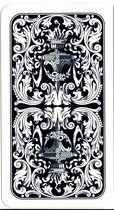
Piatnik Tarock 54 Blatt Nr. 1935. This is an Austrian-style 54-card Tarock pack. That is, 22 trumps and 32 other cards. As usual, there are king, queen, knight and jack in each suit and 7-10 in black suits and 1-4 in red suits. Cards have no indices, but the court cards are easy to tell from each other and with pip cards, the lack of indices is only problem for the black cards. In most games the pip cards are almost completely insignificant, so it often makes no difference whatsoever whether you hold eight or nine of clubs.
The trumps have Roman numerals. To me this seems more authentic for some reason than just numbers. The pictures show vaguely Eastern European countryside life. The cards are printed well and pictures have beautiful colours. The cards are slightly oversized compared to regular Bridge or Poker cards and of typical Piatnik quality.
This pack is identical to pack number 1936 except for the backs. 1936 has a subtle line pattern, this has baroque ornaments in blue and white. 1936 is my current favourite pack for 54 card games, and for all practical reasons 1935 is just as good.
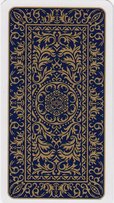
Carta Mundi Jeu de Tarot - 78 Cartes. This pack has no identification number or other details, but the back pattern is called Versailles so if you search for that, you should be able to find a whole family of backs with the same design. The pattern is blue and gold floral design, but apparently there is also a red and gold variation available. I'm not sure if there's a red and gold tarot pack, though.
In any case, this is a full 78 card pack, that is 22 trumps and 56 cards otherwise. All cards bear indices in four corners; court cards have French indices (R, D, C and V). The trumps have what is apparently a French standard pictures, but here the pictures look better than in the other French tarot pack I have. The colours are better. The trumps are numbered with Arabic numerals.
Included with the pack are the rules and a scoring card for French Tarot. The card quality is excellent. This is a very good pack for playing almost any Tarot game and my standard suggestion to people who wish to buy exactly one Tarot pack and thus want maximum versatility.












